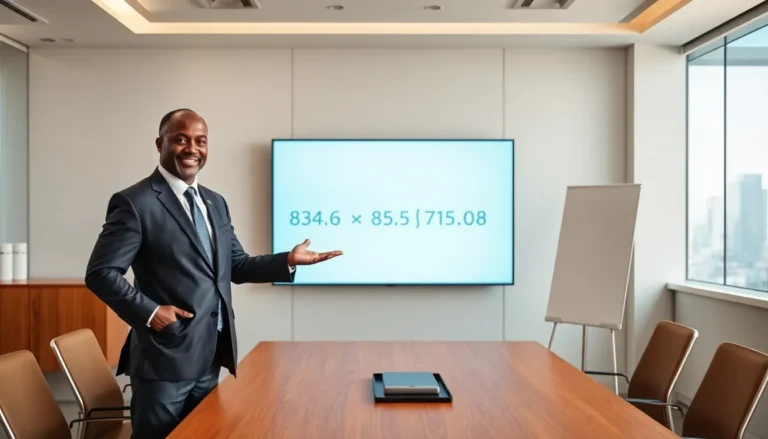Table of Contents
ToggleEver stared into the abyss of numbers and wondered, “What does it all mean?” Well, today, we’re diving into the world of multiplication, specifically the fascinating product of 83.6 and 85.5. Buckle up. It’s not just about crunching numbers: it’s about unlocking secrets to math that might just help in your next trivia night. Plus, who doesn’t love proving that math can be both fun and useful?
The Basics of Multiplication

Multiplication is often described as repeated addition. Picture it like this: if you have 83.6 apples and you want to multiply that by 85.5, you’re essentially adding 83.6 a total of 85.5 times. It’s the most efficient way to deal with large numbers. To get started, this basic understanding creates a strong foundation for mastering more complex calculations.
Generally, multiplication involves two components: the multiplicand and the multiplier. In our case, 83.6 is the multiplicand, and 85.5 is the multiplier. This operation leads to a third value, known as the product. Simple, right? Multiplication isn’t just an arithmetic operation: it’s a fundamental concept that powers everything from basic math to advanced equations. It plays a crucial role in daily life, especially when evaluating quantities.
Significance of the Multiplicative Process
Understanding multiplication and its significance can aid in various aspects of life. From cooking to construction projects, multiplication helps simplify calculations in practical applications. It allows for swift estimations and quick adjustments in time-sensitive situations.
In education, grasping multiplication is essential for progressing to more advanced topics like algebra and calculus. Also, it is foundational for understanding data analysis and statistics. Just think about how multiplication is also present in financial scenarios. Calculating interest, determining profits, and budgeting all require a solid grasp of multiplication.
Understanding the concept of multiples, like how many times does one number fit into another, opens a door to making complex problems more manageable. Being proficient in multiplication not only sharpens one’s math skills but enhances analytical and critical thinking abilities.
Calculating 83.6 x 85.5
Now, let’s tackle the problem of calculating 83.6 x 85.5. Breaking down this process can help clarify the operation for those who might find the numbers intimidating.
Step-by-Step Calculation Breakdown
First, one might align the numbers for traditional long multiplication, but that’s just one method. A simple way can be to look at each value individually. One can multiply the whole numbers first and then adjust for the decimal places.
- Multiply 836 by 855 (ignoring the decimal points for now).
- Perform the multiplication: 836 x 855 = 714,780.
- Count the total number of decimal places to account for. In 83.6, there’s one decimal place, and in 85.5, there’s also one, totaling two decimal places.
- Adjust the final product by placing the decimal point. So, 714,780 becomes 7,147.80.
Hence, the product of 83.6 x 85.5 is 7,147.80.
Using a Calculator for Quick Results
Several calculators are available today that can assist in speedy calculations. Simply input 83.6 and 85.5 into the calculator and hit the multiply button. Voila. In seconds, the calculator will present the product, reinforcing the ease of performing such calculations. This method is beneficial for those needing immediate results without delving into lengthy calculations. Don’t hesitate to use technology to simplify your calculations.
Real-World Applications of 83.6 x 85.5
So, you might be wondering, aside from performing calculations at a trivia night, where else can the multiplication of 83.6 and 85.5 come into play?
Practical Examples in Everyday Life
Picture this: a homeowner wants to decorate their space. They’ve decided on flooring that costs $83.60 per square yard and need to cover an area of 85.5 square yards. The calculation shows that they need to budget for about $7,147.80 for the flooring alone. This makes understanding multiplication applicable in home improvement and interior design decisions.
Similarly, in cooking, if a recipe that feeds four people calls for 83.6 grams of an ingredient, then doubling or tripling the recipe becomes a task of multiplication. Practical scenarios like these illustrate multiplication’s vital role in day-to-day activities.
Implications in Business and Finance
In the realm of business, the application of multiplication extends even further. Suppose a company sells a product at $83.60, expecting to sell 85.5 units daily: understanding this multiplication helps forecast revenue. A quick calculation shows potential earnings of approximately $7,147.80 each day, imperative for strategic planning and goal-setting.
This multiplication helps managers make informed decisions about resource allocation and inventory management. Hence, grasping even the simplest multiplication can have significant effects on business strategy.







